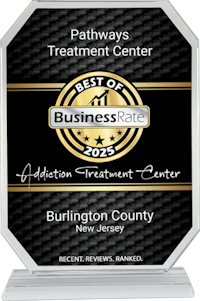
Despite the best efforts of lawmakers and advocates nationwide and even at the federal level, the opioid crisis continues to rage on in this country. Millions of Americans struggle with opioid abuse and addiction on a nearly daily basis, and as a result, the death toll continues to rise.
For those suffering from opioid use disorder (OUD), numerous treatment options are available, one of which is Medication-Assisted Treatment (MAT). While some may be apprehensive about undergoing a form of treatment that involves taking medication, MAT combines FDA-approved medications with counseling and behavioral therapies to provide a comprehensive and life-saving treatment option.
In this blog, we’ll explore what medication-assisted treatment for opioid use disorder entails, how it works, and why it is so effective. We’ll also address common myths and stigmas, highlight who benefits most from MAT, and provide insight into what MAT looks like at Pathways Treatment Center.
What Is Medication-Assisted Treatment (MAT)?
Before we get into how MAT can help specifically with opioid use disorder, let’s first discuss what exactly MAT is.
Medication-Assisted Treatment is a holistic approach to treating opioid use disorder that integrates medications with behavioral health support. The primary goal of MAT is to support those suffering from a substance use disorder in their overall recovery journey by reducing cravings, preventing withdrawal symptoms, and restoring a level of stability that enables them to engage in counseling and life-building activities.
The three main FDA-approved medications used in medication-assisted treatment are:
- Methadone– A long-acting opioid agonist that reduces cravings and withdrawal symptoms without producing a high when taken as prescribed.
- Buprenorphine– A partial opioid agonist that binds to opioid receptors in the brain, easing cravings and withdrawal while limiting the potential for misuse.
- Naltrexone– An opioid antagonist that blocks the effects of opioids entirely, used primarily in patients who have already detoxed.
For those who may be concerned about the possibility of replacing one addiction with another when it comes to these medications, these medications are designed to normalize brain chemistry, block the euphoric effects of opioids, relieve physiological cravings, and stabilize bodily functions, all without the destructive and possibly deadly highs and lows of opioid misuse.
Why MAT Is Effective for Opioid Addiction
Medication-assisted treatment has been proven to be one of the more effective treatment options for those suffering from opioid addiction for a number of reasons, such as:
- Reduces Risk of Overdose– Individuals on MAT are significantly less likely to experience a fatal overdose. This is because medications like buprenorphine and methadone reduce cravings and block opioid effects, thus dramatically lowering the risk of relapse and possible overdose.
- Improves Retention in Treatment– Those participating in MAT are significantly more likely to stay engaged in treatment for longer periods, which, in turn, correlates with better recovery outcomes.
- Restores Brain Function– Chronic opioid use alters brain chemistry. MAT medications help correct this by rebalancing neurotransmitters involved in pain and reward.
- Allows for Functional Daily Life– By stabilizing the body and brain, MAT enables individuals to return to work, repair relationships, and engage in healthy behaviors, all important aspects of sustained recovery and sobriety.
Addressing Stigma: MAT Is Not “Replacing One Drug with Another”
We touched on it earlier, but it bears repeating. The concept of medication-assisted treatment is not just simply replacing one drug with another. Unfortunately, many people out there, including some healthcare professionals, even believe that using medications like methadone or buprenorphine is just substituting one addiction for another.
This myth is not only harmful but also dangerous.
So, to set the record straight once and for all, here are a few of the reasons why those beliefs are simply not true:
Unlike “street drugs”, medications administered during medication-assisted treatment are done so under strict supervision, typically at a treatment facility as part of a larger inpatient treatment program. As a result, doses are carefully tailored to each person in a manner that is designed to minimize the chances of misuse or abuse, while also achieving the desired therapeutic benefits.
When taken as directed, these medications do not produce any euphoric effects whatsoever. In fact, should someone try and take an opioid while on a MAT medication, the medication actually blocks the euphoric effect, making the opioid less desirable. What MAT medications do produce is the stabilization needed for those in treatment to return to normal brain functionality.
At the end of the day, addiction of any kind is a disease. If someone is suffering from a condition such as diabetes or heart disease, it is fairly common that their doctor will prescribe them medications to treat or address their condition. Addiction should be viewed no differently.
Leading organizations, including the CDC, SAMHSA, and WHO, recognize MAT as the gold standard for opioid use disorder treatment. Furthermore, the medications often administered during MAT are FDA tested and approved for the purposes of opioid addiction treatment.
Who Benefits Most from MAT?
While MAT may not be best for everyone, it can be particularly effective for those struggling with moderate to severe opioid use disorder, specifically in instances where:
- You’ve tried detoxing or abstinence-based rehab, but relapsed
- You experience intense physical cravings and withdrawal symptoms
- You’ve used heroin or synthetic opioids like fentanyl
- You want to reduce your risk of overdose
- You have a history of using opioids for chronic pain and have developed a dependence
- You want to stabilize your life and focus on rebuilding relationships, employment, or education

What to Expect During MAT at Pathways Treatment Center
At Pathways Treatment Center, we take a personalized, compassionate approach to medication-assisted treatment for opioid addiction. We understand that every individual’s journey with addiction is different, which is why we tailor treatment plans to fit each person’s needs.
Our MAT Program Typically Includes:
The first step is to meet with our medical and behavioral health team to evaluate your physical health, substance use history, and mental health needs.
If needed, you may need to undergo medically supervised detox. From there, you are started on the appropriate MAT medication such as buprenorphine, methadone, or naltrexone.
MAT is most effective when combined with therapy. We offer individual counseling, group therapy, trauma-informed care, and cognitive behavioral therapy (CBT).
Our team regularly monitors medication levels, side effects, and overall well-being to adjust the treatment plan as needed.
We help with important post-treatment things such as employment readiness, housing stability, relapse prevention, and relationship rebuilding.
Before completing the program, you will receive a comprehensive aftercare plan to support long-term sobriety.
Pathways is not just a place to get sober, it’s a place to get better. Our MAT program focuses on healing the whole person: body, mind, and spirit.
Long-Term Recovery with MAT: What the Research Says
Studies have shown that MAT significantly improves the odds of long-term recovery from opioid addiction. When MAT is done for at least a year, it provides durable protection against relapse.
In fact, long-term participation in medication-assisted treatment has been shown to:
- Reduce the risk of overdose– MAT can reduce opioid overdose deaths by up to 50%, according to the NIH.
- Improve overall functioning– Patients on MAT are more likely to hold jobs, remain in housing, and maintain family connections.
- Increase retention rates– MAT programs see far higher retention rates compared to abstinence-only treatment models.
- Lower criminal justice involvement– According to a journal article published by the American Psychological Association, studies show reductions in arrests and criminal behavior among MAT participants.
While it’s important to remember that MAT is not a quick fix or a miracle cure, it lays the foundation for sustainable recovery. Many patients participate in medication-assisted treatment for years and live fulfilling, productive lives. Some eventually taper off medications under medical guidance, while others may stay on long-term to protect their recovery.
At Pathways, we honor each individual’s goals, whether that means long-term maintenance or eventual discontinuation. The goal is not to impose a rigid timeline, but to support a safe, stable, and empowered recovery journey.
Final Thoughts: Is Medication-Assisted Treatment for Opioid Use Disorder Right for You or a Loved One?
If you or someone you love is struggling with opioid addiction, it’s important to remember that recovery is possible, and help is available. It’s also important to remember that MAT is not a last resort; it’s a first step toward long-term sobriety.
At Pathways Treatment Center, we are here to help you every step of the way. Our experienced team provides comprehensive care that meets you where you are and helps you build a life free from the grip of opioids.
Whether you’re seeking MAT for the first time, re-entering treatment after a relapse, or exploring your options, contact us today.



